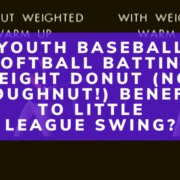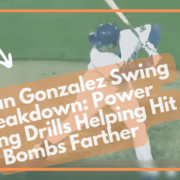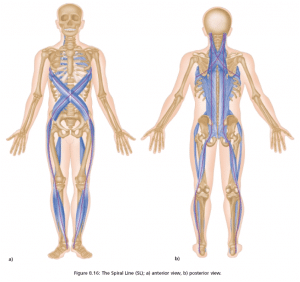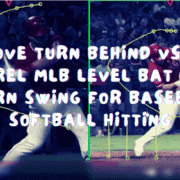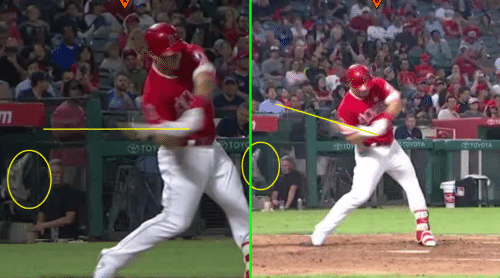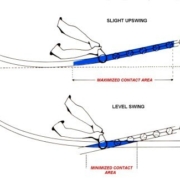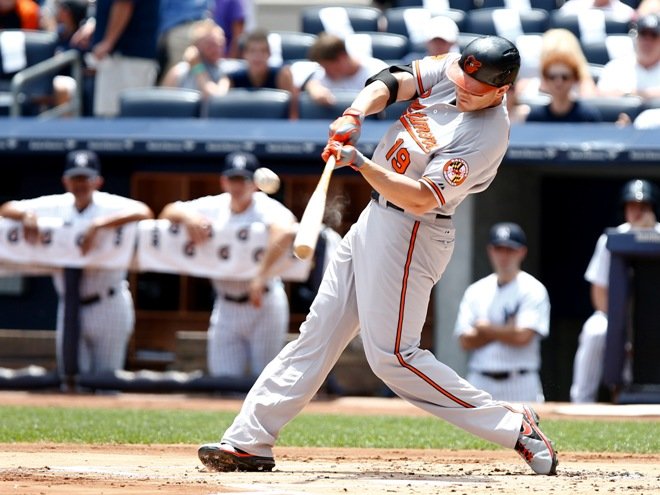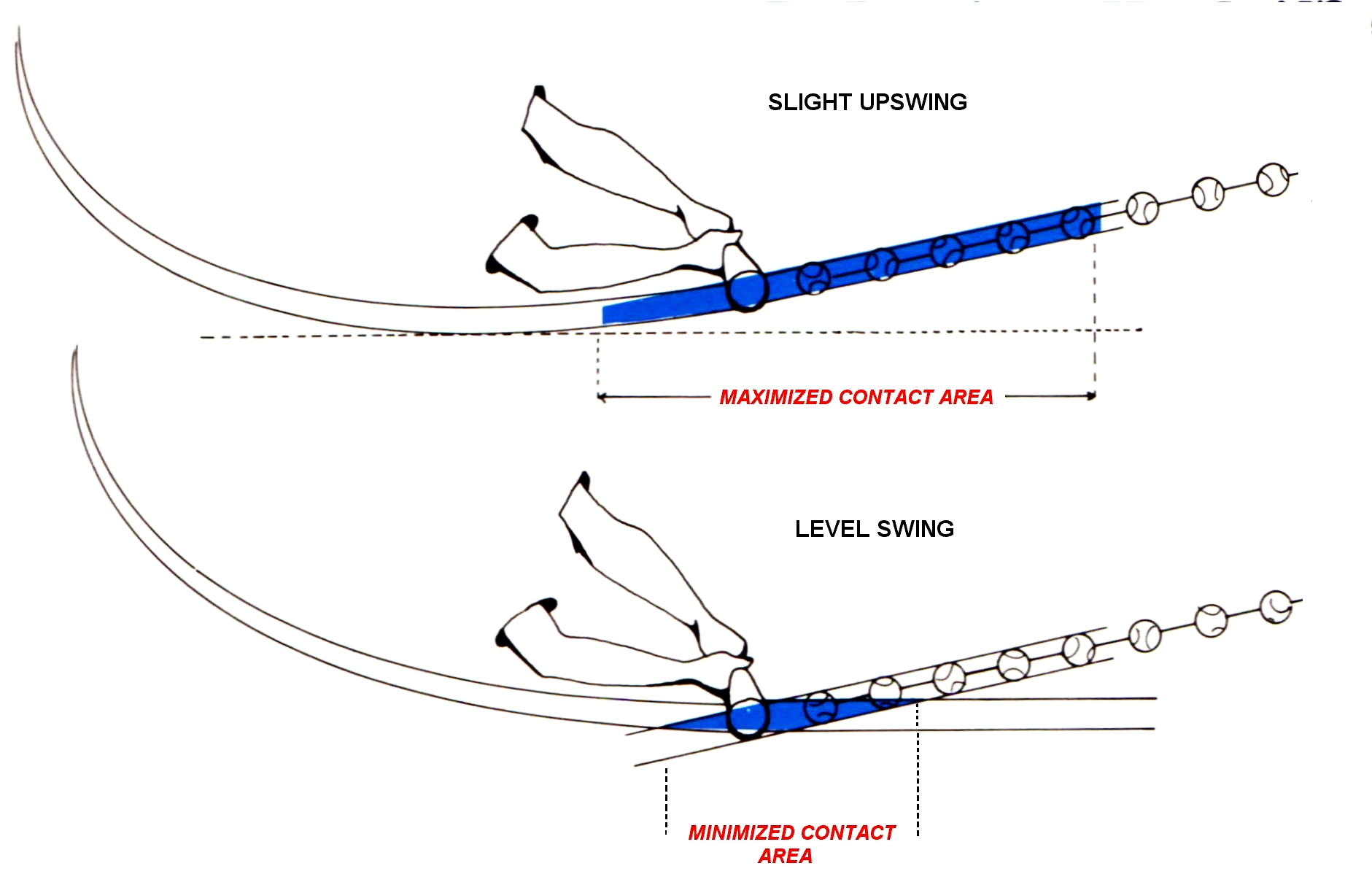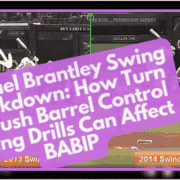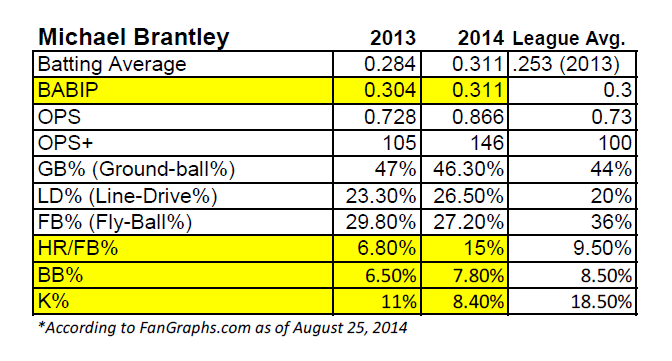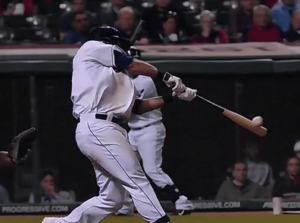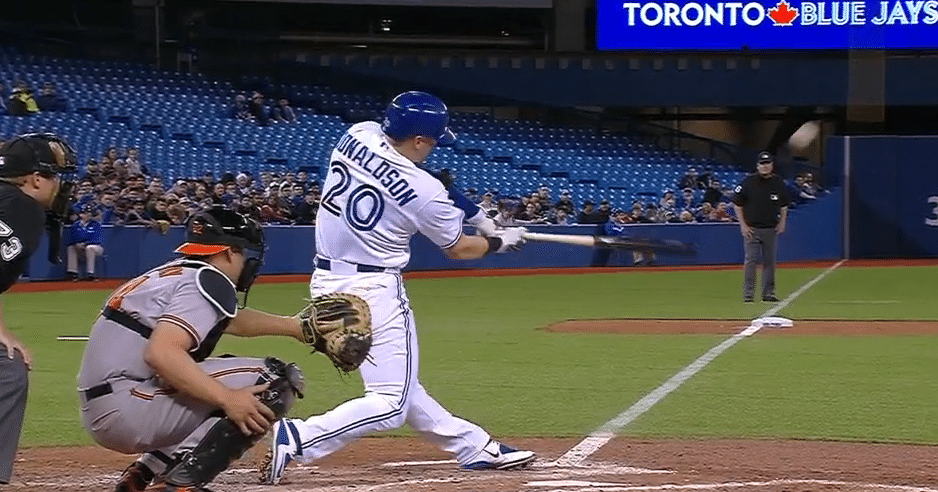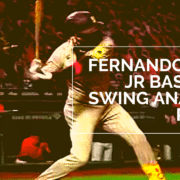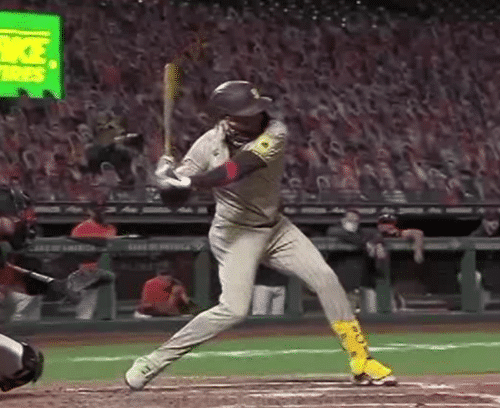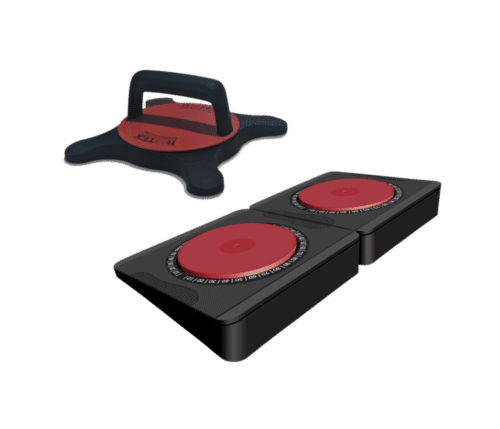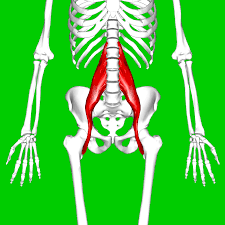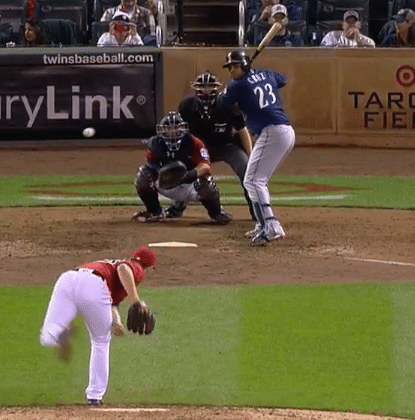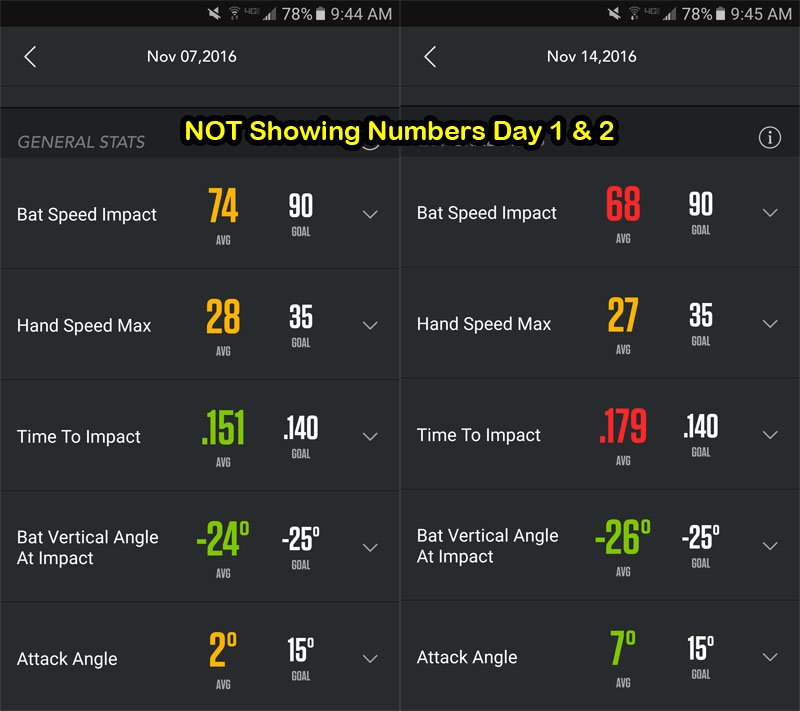Discover in this Fernando Tatis Jr. swing breakdown and analysis…how to use the lower half and legs, stride, how much hip rotation, and arm bar for baseball and softball hitting athletes.
Fernando Tatis Jr Baseball Swing Analysis Part-2
Here’s what we’re talking about in this Fernando Tatis Jr baseball swing analysis:

Fernando Tatis Jr Baseball Swing Analysis Part-2 photo courtesy: MLB.com
- Distance between feet – Getting to a balanced position on our stride,
- Staying sideways with lower half – most still want to pivot on back foot instead of with the hip, and
- Front arm shape – Arm bar a problem?
The following is the transcription from the above video. Time stamped of course, so you can skip ahead if you’d like. And in case you missed Part-1, then check it out Here.
Enjoy!
00:38
Remember, in part one, we went over some fangraphs stats, Fernando Tatis Jr. We talked about catapult loading system principles and how he uses them in his swing. And we also talked a little bit about staying sideways there as well. We will go in a little bit more depth in this video.
Distance between feet – Getting to a balanced position on Fernando Tatis Jr baseball swing’s stride
SCIENCE-BASED TRAINING:
Improve your hitting strategy dramatically by applying human movement principles.
Learn not only how and what to train but also the science behind the methods.
00:56
Let’s talk about the distance between the feet and getting to a balanced position in the stride. First, I wanted to give you a little context between these pitches, the one on the left, I think both of these are 2020. The one on the right we talked about in part one, but this one is a low and in breaker. Slower than average pitch.
01:18
And then this one over here, if you remember was a fastball up and in. Just to give each context there. On the left, we’ll go… there’s three swings over here. The first one will be this one, and then the other two I don’t have the pitchers view on, so we will look at the distance between the feet.
01:37
One of the things that elite hitters have in common is they get distance between their feet at stride landing and during their turn. A lot of young hitters tend to either be too narrow, don’t get a long enough stride or if they skip their back foot they skip too far, creating more of narrow feet during the turn itself.
01:55
Elite hitters don’t do that, elite hitters will create distance between their feet. It makes for a more athletic position and allows them to be able to, if they want to use their knees to get to pitches down in the zone like a Cody Bellinger or an Anthony Rizzo or Dustin Pedroia, they can do that. With narrow feet during the turn, it’s not going to happen.
02:16
So as this also applies to getting to balance at your stride landing, you’re going to notice that in Fernando Tatis Jr baseball swing, that he is not going to be very heavy on that front foot as he lands. You can see that, and we’ll get to this a little later in the video, this idea of shifting foot pressure. But if we look at this little ride or float, we like to call the float, Matt Nokes calls the ride and then the stride or the fall we call it the float in the fall.
02:49
You can see that there isn’t a 100% commitment to the front leg yet. It’s a little bit more uncommitted, feeling out, being more controlled, and there’s different drills that you can do for this you can put weight on the front foot, like a band pulling the front foot forward or the band pulling the hitters body forward wrapped around their waist, and the coach is out in front pulling the bands, and the hitter’s got to resist the band. Got to resist gravity from landing too hard and heavy on that front foot.
03:17
But that’s what you’re going to see. You’re going to see that distance between the foot and as he begins his turn, you will see him maintain the distance between his feet. Look out over here. Very light and hover-y with that front foot at landing. And you see there’s a little bit of a glide or skip of the back foot.
03:46
Here’s another swing. You can see this really controlled fall, it is a fall because you will see him unweight that back leg completely with the skipping of that back foot or the scissoring into that back foot. But at first before the stride foot lands, you’re going to see this very tentative with the weight. He’s going to get to the end of his hip, front hip and that’s going to allow him to rotate without having to shift more during the turn as he rotates.
04:31
A lot of hitters, young hitters, will get to landing and then they’ll continue to shift forward with their hips as they’re turning the barrel. In both baseball and softball. We want to get to the end of that hip, front hip. As we land, that’s it. There’s no more shifting of the hip, of the weight. We should be done shifting, then as we start to turn, that head should stay still, shouldn’t move anymore once a stride foot hits the ground.
05:07
Here’s the fourth swing. You can see this hover, he’s still committing his weight forward, but it’s controlled. Again, we can stand out in front of this hitter, and we can wrap a band, resistance band around their waist, we can hold the handles and pull them forward and they have to resist our pull forward, that is a way to help with this… not committing that weight 100% at stride touchdown.
05:37
We’ll get the hip to the endpoint, which is right there. And then as the turn starts, and on this pitch Tatis is a little bit out in front looks almost like a Jose Bautista swing. But that is a way to stay balanced and making sure we maintain distance between the feet.
'Add 40-Feet' To Batted Ball Distance
Swing Study reveals how tens of thousands of hitters are adding 40-feet to batted ball distance by using one simple strategy.
Click the button below to access the FREE video that's been downloaded over 30K times!!
Click here to 'Get Instant Access'
Staying sideways with lower half – most still want to pivot on back foot instead of with the hip
05:57
Now let’s talk about staying sideways. There’s this tendency for hitting coaches out there, and for usually the older kids, the younger ones that are under coached tend to do this correctly. But the ones that have been over coached a little bit will tend to want to pivot on that back foot. And these coaches are teaching them to pivot on the back foot to get the hips through. And that’s not what we’re looking for.
06:20
The hips aren’t, rotation of the hips, maximum rotation of the hip isn’t where power is coming from, not most of the power anyway. The hips and the pelvis are about 33% of the equation when it comes to the spinal engine. Thoracic spine, the spine is split into three, the cervicles – the neck, thoracic – the middle, the bigger part of the spine, and then you have the lumbar is the lower part.
06:43
Those three sections, along with the shoulders, and the pelvis surrounding that are where most of the power is. The pelvis and the hips are a very small percentage of that, 33% or so, if you split it in three. What we see is this shifting foot pressure, you’ll see where you got foot pressure on the outside of the back foot, inside of the front foot up to landing.
07:14
And then same over here. This is a different angle. But you can see the inside of the front foot here, can see it over on the right and outside, it’s starting to shift. And then as the turn starts, the foot pressure on the part of the foot will shift completely opposite side. Back one will go from outside to inside. You can see the insides already starting to shift here on the left pane. Same thing on the right pane, you’re also going to see the front foot do the opposite, it’s going to go from the inside to the outside.
07:47
Staying sideways and making sure we get to the end of the front hip at landing. We’re going to see that bowing in here. The inside of the back foot when we see kids turning that back foot. By this point, the foot is almost vertical. And they’re turning what we say is with the middle of the foot instead of the inside of the foot. What we should see is what Fernando Tatis Jr baseball swing analysis is doing, one on the left you’re seeing a little bit more vertical but then he pushes that heel down and stays inside.
08:25
Remember this pitch was the breaker the slower breaker down and in. He was a little bit out in front of this you can tell just by where the barrel is entering the zone. It’s not knocking off the real catcher’s glove, which is back here. It’s actually between the back-foot catcher’s glove and the belly button catcher’s glove. A little bit out in front, over here on the right, can see the same inside back foot, you can see the front foot clearly go from inside to outside, pushes that back heel behind him.
08:59
The hips are for direction, not for 100% complete rotation. That’s not where the power is coming from, the hips set directional force. Here’s another swing, same thing outside of the back foot inside of the front foot. You’re going to see that all the way until about landing, and then we’re going to see the shift happen inside of the back foot outside of the front foot. push that back heel behind them.
09:29
Fourth swing, outside of the back foot, inside of the front foot going to stay sideways, we’re not going to pivot on that back foot. Like most young hitters do that coaches have taught him to do that. The youngest hitters 7, 8, 9… They tend to do this on their own if we don’t touch them. Same shifting the foot pressure. This one he actually scissors is a little bit more out in front than he was on that first swing, and you can see big time skip and hop, don’t like the hop so much, but this is just a compensation, you didn’t see that in the other three swings, but he is scissoring here to keep his balance on this swing.
10:13
You can see our lower half, combination of distance between the feet. This allows the hitter to keep a balance into their stride by staying sideways, and in doing so, shifting our foot pressure from outside of the back foot, inside of the front foot to, during the turn inside of the back foot, outside of the front foot allows the pelvis in the lower half to control and guide our directional force.
'Add 40-Feet' To Batted Ball Distance
Swing Study reveals how tens of thousands of hitters are adding 40-feet to batted ball distance by using one simple strategy.
Click the button below to access the FREE video that's been downloaded over 30K times!!
Click here to 'Get Instant Access'
Front arm shape – Arm bar a problem?
10:46
Alright, let’s talk about is the arm-bar okay? I hear a lot of coaches out there like to teach the adjustable swing, meaning look away, adjust in, or look in and adjust the way. And when you start facing better pitching that just doesn’t work. We can’t get to balls and be able to maximize our ball exit speed inside with an elbow bent at 90 degrees.
11:08
You’ll see in the four swings of this Fernando Tatis Jr baseball swing analysis; he’ll do a very good job of maintaining the shape of that front arm. Maintaining the shape of the front arm will allow consistency in the performance of the swing. And the longer the front arm, the longer the lever is, an engineering principle, the more the force gets multiplied at the end of the lever. It’s both power or ball exit speed, batted ball distance, and consistency.
11:40
We can get to an inside pitch, or a pitch up in the zone with a straight barred out front arm, but it’s when the hitters barrel enters the zone is what really matters. It’s not about the length of the front arm if it’s getting locked out. As much as it is when the barrel enters the zone, and the coaches that teach the barrel to get into the zone super early, knocking off the real catcher’s glove. Are going to have a hard time getting the barrel to the ball on the inner half part of the plate or getting to the ball on the middle up part of the zone.
12:16
But it’s not because of the front arm shape, it is because of when the barrel is entering the zone. The best hitters in the world change, instinctively, we can teach it but instinctively change when their barrel enters the zone. That’s another topic for another video. But let’s look over here at our first swing. Fernando Tatis Jr baseball swing analysis, you’re going to see that front arm shape almost from the start of the turn.
12:45
Again, this one is a breaking ball that was probably 80-ish miles an hour, located down and in the part of the zone. You can see the arms fully locked out, see where the barrels at? Barrel is tight to the back shoulder. And then you’re going to start to see him unwind and release the barrel, like I said earlier in this video, is going to be somewhere between the back foot catcher’s glove… If you can if you can imagine a catcher’s glove in line with his back foot, and a catcher’s glove in line with his belly button.
13:15
He releases it somewhere in the middle of those, being a little bit out in front of this ball and this ball being on the inner, the lower inner part of the zone. See the front arm shape there, is a different angle, but you can still see he pulls in just a little bit here you can see he’s a little bit bent. But he works it to get in, it’s very minimal. That will screw up consistency a little bit, if we have a hitter that’s doing this all the time. Fernando Tatis Jr is doing this to be able to catch up to this fastball. And this one was remember, located up and in, in the zone, a fastball up and in…
13:27
A little bit, but we don’t see a 90-degree chicken wing getting to this ball especially at a contact. You can see that front arm shape is complete, almost completely barred out to get to this ball. And he’s got something we’ll talk about another video wrist snap, beautiful wrist snap, you can see in this swing, same thing. Watch that front arm shape. From the start of the turn, you see the front arm shape, almost completely barred out slight bend can be argued with it.
14:25
Can see barrel’s entering the zone, again we don’t have a pitcher’s view of this pitch, but you can see is entering the zone off his back foot. He’s releasing that barrel off his shoulder and then slamming it into the back-foot catcher’s glove, not in the real catcher’s glove because real catcher’s glove you can see is farther away. But he’s releasing it off his back-foot catcher’s glove.
14:51
But look at the shape of that front arm. Got a lot of consistency there and you have a long lever so that at impact it’s going to amplify the force at the end of that lever. Last swing, front arm shape, started the turn, you can see it’s almost completely barred out. He’s a little out in front on this one, remember, probably more out in front than the other three swings.
15:27
You can see the blur of the bat, is happening again, he’s releasing this into the belly button catcher’s glove. Because he’s out in front, we’ll see that on timing. When they’re out in front, we’ll see the barrel get released later into the zone, not early. Later. You see that front arm shape is completely barred out on this one. Trout does this too. If he’s out in front, and the balls middle away or middle down, you’ll see that straight up front arm, but he’s a little different when it comes to middle in, middle up especially if it’s something hard. Plus velocity, you’ll see a 90 degree bend in that front arm…
16:04
But you can see boom, completely arm barred with the front arm at impact. This is going to amplify the force at the end of that lever. And because he’s keeping a consistent long shape with that front arm to get to this ball, it’s going to lead to some consistency. And in this Fernando Tatis Jr baseball swing analysis, those of you who have been charting him in the 2020 season, have seen the consistency throughout the season. Albeit a shortened 60 game college season. We’ll see what happens in the playoffs.
16:38
Just a quick recap of this Fernando Tatis Jr baseball swing analysis video,
- We talked about the distance between the feet getting into a balanced position on our stride.
- We also went into staying sideways with the lower half a little bit more depth, because most still want to pivot on the back foot instead of with the hip, the front hip we talked about.
- And front arm shape, is the armbar a problem? And we saw in four separate swings that Fernando Tatis Jr. in his baseball swing does a very good job of keeping a longer front arm, which helps with consistency and batted ball distance.
Make sure that we’re swinging smarter by moving better, and before I let you go…
'Add 40-Feet' To Batted Ball Distance
Swing Study reveals how tens of thousands of hitters are adding 40-feet to batted ball distance by using one simple strategy.
Click the button below to access the FREE video that's been downloaded over 30K times!!
Click here to 'Get Instant Access'

